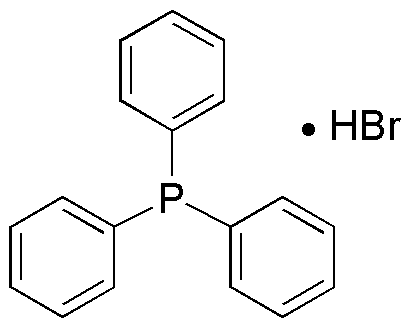Triphenylphosphine hydrobromide is widely utilized in research focused on:
- Synthesis of Organophosphorus Compounds: This chemical serves as a key reagent in the synthesis of various organophosphorus compounds, which are important in pharmaceuticals and agrochemicals.
- Catalysis in Organic Reactions: It acts as a catalyst in several organic reactions, enhancing reaction rates and yields, particularly in the formation of carbon-phosphorus bonds.
- Pharmaceutical Development: It is used in the development of new drugs, especially in the creation of phosphine-based ligands that can improve the efficacy of therapeutic agents.
- Material Science: In the field of material science, it is applied in the development of advanced materials, including polymers and coatings that require specific chemical properties.
- Analytical Chemistry: Triphenylphosphine hydrobromide is also utilized in analytical chemistry for the detection and quantification of various compounds, providing reliable results in research and quality control.
General Information
Properties
Safety and Regulations
Applications
Triphenylphosphine hydrobromide is widely utilized in research focused on:
- Synthesis of Organophosphorus Compounds: This chemical serves as a key reagent in the synthesis of various organophosphorus compounds, which are important in pharmaceuticals and agrochemicals.
- Catalysis in Organic Reactions: It acts as a catalyst in several organic reactions, enhancing reaction rates and yields, particularly in the formation of carbon-phosphorus bonds.
- Pharmaceutical Development: It is used in the development of new drugs, especially in the creation of phosphine-based ligands that can improve the efficacy of therapeutic agents.
- Material Science: In the field of material science, it is applied in the development of advanced materials, including polymers and coatings that require specific chemical properties.
- Analytical Chemistry: Triphenylphosphine hydrobromide is also utilized in analytical chemistry for the detection and quantification of various compounds, providing reliable results in research and quality control.
Documents
Safety Data Sheets (SDS)
The SDS provides comprehensive safety information on handling, storage, and disposal of the product.
Product Specification (PS)
The PS provides a comprehensive breakdown of the product’s properties, including chemical composition, physical state, purity, and storage requirements. It also details acceptable quality ranges and the product's intended applications.
Certificates of Analysis (COA)
Search for Certificates of Analysis (COA) by entering the products Lot Number. Lot and Batch Numbers can be found on a product’s label following the words ‘Lot’ or ‘Batch’.
*Catalog Number
*Lot Number
Certificates Of Origin (COO)
This COO confirms the country where the product was manufactured, and also details the materials and components used in it and whether it is derived from natural, synthetic, or other specific sources. This certificate may be required for customs, trade, and regulatory compliance.
*Catalog Number
*Lot Number
Safety Data Sheets (SDS)
The SDS provides comprehensive safety information on handling, storage, and disposal of the product.
DownloadProduct Specification (PS)
The PS provides a comprehensive breakdown of the product’s properties, including chemical composition, physical state, purity, and storage requirements. It also details acceptable quality ranges and the product's intended applications.
DownloadCertificates of Analysis (COA)
Search for Certificates of Analysis (COA) by entering the products Lot Number. Lot and Batch Numbers can be found on a product’s label following the words ‘Lot’ or ‘Batch’.
*Catalog Number
*Lot Number
Certificates Of Origin (COO)
This COO confirms the country where the product was manufactured, and also details the materials and components used in it and whether it is derived from natural, synthetic, or other specific sources. This certificate may be required for customs, trade, and regulatory compliance.


